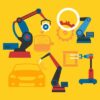Automotive Airbags Market Summary:
Airbags have become an essential safety feature in modern vehicles, providing protection to occupants during collisions and reducing the risk of severe injuries. The automotive airbags market has witnessed significant growth in recent years, driven by the increasing focus on passenger safety and the rising number of road accidents worldwide. One of the key factors driving the growth of the automotive airbags market is the stringent safety regulations imposed by governments across the globe. These regulations mandate the installation of airbags in vehicles to ensure the safety of passengers. Additionally, the growing awareness among consumers regarding the importance of safety features in vehicles has also contributed to the market’s expansion. The market is witnessing a shift towards advanced airbag technologies, such as side-impact airbags, knee airbags, and curtain airbags. These advanced airbags provide enhanced protection to occupants during different types of collisions. Moreover, the integration of sensors and electronic control units in airbag systems has further improved their effectiveness and reliability.
The increasing demand for luxury and premium vehicles has also fueled the growth of the automotive airbags market. Consumers are willing to pay a premium for vehicles equipped with advanced safety features, including airbags. Additionally, the rising disposable income and improving living standards in emerging economies have led to an increase in vehicle ownership, further boosting the demand for automotive airbags. The automotive airbags market is experiencing significant growth due to the increasing focus on passenger safety, stringent safety regulations, and the demand for advanced safety features in vehicles. As the automotive industry continues to evolve, the adoption of innovative airbag technologies is expected to further drive the market’s growth.
Automotive Airbags Market Overview:
The Automotive Airbags Market overview provides a comprehensive understanding of the analyzed market. It includes an introduction to the market, its size, growth rate, and key trends. This aims to give clients a broad understanding of the market landscape. The market analysis of the Automotive Airbags Market delves deeper into the market dynamics, focusing on factors such as market drivers, challenges, and opportunities. It explores the macroeconomic and microeconomic factors affecting the market, industry regulations, and emerging market trends. The analysis provides valuable insights into the current and future market conditions.
The assessment of the Automotive Airbags Market is performed by taking various factors into consideration, like, for instance, the business expansion policies of key players, competitive analysis of the progress of new entrants and emerging players, and the revenue, financial, and opportunity analysis of market players. The also analyzed based on regional segmentation, type or technique, end-user spectrum, etc. This research implements the latest methodologies to help clients understand the overall market scenario and strategize accordingly. The Automotive Airbags Market report provides an overview of the different types of analysis conducted during the market research process, including but not limited to SWOT analysis, Porter's Five Forces analysis, PESTLE analysis, and market forecasting. These analyses provide a deeper understanding of the market dynamics and assist in making informed business decisions.
Major players included in the Automotive Airbags Market:
- Autoliv, Inc.
- Takata Corporation
- Daicel Corporation
- Denso Corporation
- Hyundai Mobis Co. Ltd.
- Toyoda Gosei Co. Ltd.
- ZF Friedrichshafen AG
- Kolon Industries, Inc.
- Toray Industries, Inc.
- Porcher Industries SA
- Nihon Plast Co. Ltd.
- Delphi Automotive PLC
- Wacker Chemie AG
- Hyosung Co.
- Toyobo Co., Ltd.
Automotive Airbags Market Segmentation:
By Vehicle Type
- Passenger Car
- Light Commercial Vehicle
- Heavy Commercial Vehicle
By Product Type
- Driver Airbag
- Passenger Airbag
- Side Airbag
- Curtain Airbag
- Knee Airbag
- Other Airbags
By Coating Type
- Neoprene
- Silicone
- Non-Coated
By Yarn Type
- Nylon
- Polyester
By Sales Channel
- Original Equipment Manufacturers (OEMs)
- Aftermarkets
Future Market Analytics Focus Points:
- SWOT Analysis
- Key Market Trends
- Key Data -Points Affecting Market Growth
- Revenue and Forecast Analysis
- Growth Opportunities For New Entrants and Emerging Players
- Key Player and Market Growth Matrix
Automotive Airbags Market Competitive Analysis:
The competitive analysis of the Automotive Airbags Market assesses the competitive landscape of the market. It includes evaluating key players in the industry, their market share, business strategies, and competitive advantages. The competitive analysis also highlights the strengths and weaknesses of major competitors, allowing clients to understand the competitive positioning of companies operating in the market.
Objectives of the Study:
- To provide a comprehensive analysis on the Automotive Airbags Market by segmentation and by region
- To cater extensive insights on factors influencing the market growth (drivers, restraints, industry-specific restraints, business expansion opportunities)
- To anticipate and analyse the market size expansion in key regions- North America, Europe, Asia Pacific, Latin America and Middle East and Africa
- To record and evaluate competitive landscape mapping- strategic alliances and mergers, technological advancements and product launches, revenue and financial analysis of key market players
How our market research reports help clients:
Our market research reports provide valuable insights to clients in their decision-making process and support their growth and market capture efforts. They offer:
- Comprehensive understanding of market trends, dynamics, and growth potential.
- Identification of niche markets and emerging opportunities.
- Assessment of competitive landscape and strategic benchmarking.
- Insights into consumer preferences, buying behavior, and market demand.
- Risk assessment and mitigation strategies.
- Market forecasting and trend analysis for informed business planning.
- Understanding product development, pricing, and other strategies.
In case of any specific requirements or changes to the current table of content based on your scope, please contact us at: enquiry@futuremarketanalytics.com






















